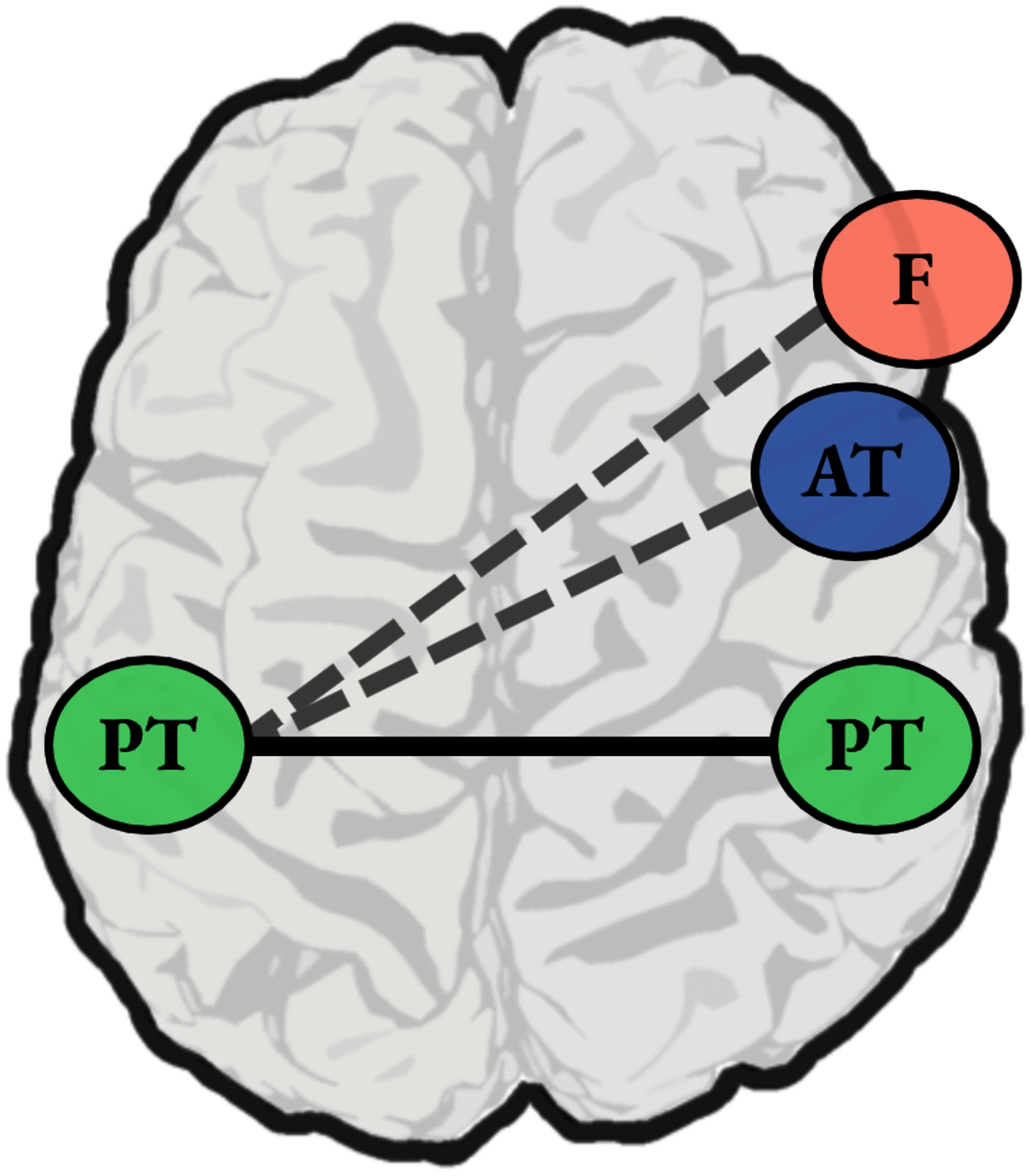The Role of the Right Hemisphere in Processing Phonetic Variability Between Talkers
- PMID: 37213418
- PMCID: PMC10174361
- DOI: 10.1162/nol_a_00028
The Role of the Right Hemisphere in Processing Phonetic Variability Between Talkers
Abstract
Neurobiological models of speech perception posit that both left and right posterior temporal brain regions are involved in the early auditory analysis of speech sounds. However, frank deficits in speech perception are not readily observed in individuals with right hemisphere damage. Instead, damage to the right hemisphere is often associated with impairments in vocal identity processing. Herein lies an apparent paradox: The mapping between acoustics and speech sound categories can vary substantially across talkers, so why might right hemisphere damage selectively impair vocal identity processing without obvious effects on speech perception? In this review, I attempt to clarify the role of the right hemisphere in speech perception through a careful consideration of its role in processing vocal identity. I review evidence showing that right posterior superior temporal, right anterior superior temporal, and right inferior / middle frontal regions all play distinct roles in vocal identity processing. In considering the implications of these findings for neurobiological accounts of speech perception, I argue that the recruitment of right posterior superior temporal cortex during speech perception may specifically reflect the process of conditioning phonetic identity on talker information. I suggest that the relative lack of involvement of other right hemisphere regions in speech perception may be because speech perception does not necessarily place a high burden on talker processing systems, and I argue that the extant literature hints at potential subclinical impairments in the speech perception abilities of individuals with right hemisphere damage.
Keywords: functional neuroimaging; phonetic variability; right hemisphere; speech perception; talker identity; vocal identity.
© 2021 Massachusetts Institute of Technology.
Conflict of interest statement
Competing Interests: The author has declared that no competing interests exist.
Figures


Similar articles
-
Right Posterior Temporal Cortex Supports Integration of Phonetic and Talker Information.Neurobiol Lang (Camb). 2023 Mar 8;4(1):145-177. doi: 10.1162/nol_a_00091. eCollection 2023. Neurobiol Lang (Camb). 2023. PMID: 37229142 Free PMC article.
-
Using TMS to evaluate a causal role for right posterior temporal cortex in talker-specific phonetic processing.Brain Lang. 2023 May;240:105264. doi: 10.1016/j.bandl.2023.105264. Epub 2023 Apr 21. Brain Lang. 2023. PMID: 37087863 Free PMC article.
-
Task-modulated Sensitivity to Vocal Pitch in the Dorsal Premotor Cortex during Multitalker Speech Recognition.J Cogn Neurosci. 2022 Oct 1;34(11):2189-2214. doi: 10.1162/jocn_a_01907. J Cogn Neurosci. 2022. PMID: 36007073
-
Stimulus-dependent activations and attention-related modulations in the auditory cortex: a meta-analysis of fMRI studies.Hear Res. 2014 Jan;307:29-41. doi: 10.1016/j.heares.2013.08.001. Epub 2013 Aug 11. Hear Res. 2014. PMID: 23938208 Review.
-
Do temporal processes underlie left hemisphere dominance in speech perception?Brain Lang. 2013 Oct;127(1):36-45. doi: 10.1016/j.bandl.2013.07.006. Brain Lang. 2013. PMID: 24125574 Free PMC article. Review.
Cited by
-
Neuroimaging Findings for the Overnight Consolidation of Learned Non-native Speech Sounds.Neurobiol Lang (Camb). 2025 Jan 10;6:nol_a_00157. doi: 10.1162/nol_a_00157. eCollection 2025. Neurobiol Lang (Camb). 2025. PMID: 39830070 Free PMC article.
-
Why are listeners hindered by talker variability?Psychon Bull Rev. 2024 Feb;31(1):104-121. doi: 10.3758/s13423-023-02355-6. Epub 2023 Aug 14. Psychon Bull Rev. 2024. PMID: 37580454 Free PMC article. Review.
-
Right Posterior Temporal Cortex Supports Integration of Phonetic and Talker Information.Neurobiol Lang (Camb). 2023 Mar 8;4(1):145-177. doi: 10.1162/nol_a_00091. eCollection 2023. Neurobiol Lang (Camb). 2023. PMID: 37229142 Free PMC article.
-
Using TMS to evaluate a causal role for right posterior temporal cortex in talker-specific phonetic processing.Brain Lang. 2023 May;240:105264. doi: 10.1016/j.bandl.2023.105264. Epub 2023 Apr 21. Brain Lang. 2023. PMID: 37087863 Free PMC article.
-
Bridging the translational gap: what can synaptopathies tell us about autism?Front Mol Neurosci. 2023 Jun 27;16:1191323. doi: 10.3389/fnmol.2023.1191323. eCollection 2023. Front Mol Neurosci. 2023. PMID: 37441676 Free PMC article. Review.
References
-
- Abrams, D. A. , Nicol, T. , Zecker, S. , & Kraus, N. (2008). Right-hemisphere auditory cortex is dominant for coding syllable patterns in speech. The Journal of Neuroscience, 28(15), 3958–3965. DOI: https://doi.org/10.1523/JNEUROSCI.0187-08.2008, PMID: 18400895, PMCID: PMC2713056 - DOI - PMC - PubMed
-
- Allen, J. S. , & Miller, J. L. (2004). Listener sensitivity to individual talker differences in voice-onset-time. The Journal of the Acoustical Society of America, 115(6), 3171–3183. DOI: https://doi.org/10.1121/1.1701898, PMID: 15237841 - DOI - PubMed
-
- Allen, J. S. , Miller, J. L. , & DeSteno, D. (2003). Individual talker differences in voice-onset-time. The Journal of the Acoustical Society of America, 113(1), 544–552. DOI: https://doi.org/10.1121/1.1528172, PMID: 12558290 - DOI - PubMed
-
- Andics, A. , McQueen, J. M. , & Petersson, K. M. (2013). Mean-based neural coding of voices. NeuroImage, 79, 351–360. DOI: https://doi.org/10.1016/j.neuroimage.2013.05.002, PMID: 23664949 - DOI - PubMed
-
- Andics, A. , McQueen, J. M. , Petersson, K. M. , Gál, V. , Rudas, G. , & Vidnyánszky, Z. (2010). Neural mechanisms for voice recognition. NeuroImage, 52(4), 1528–1540. DOI: https://doi.org/10.1016/j.neuroimage.2010.05.048, PMID: 20553895 - DOI - PubMed
Publication types
LinkOut - more resources
Full Text Sources
